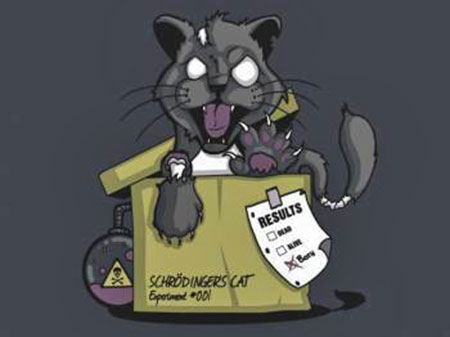|

by Anna LeMind
March 24, 2014
from
Learning-Mind Website
Spanish version

Is this reality an illusion?
Are we living inside a matrix?
The following article provides 'food for
thought'
about the reality we THINK we are
experiencing.
No one in the world can fathom what
quantum mechanics is, this is perhaps the most important thing you
need to know about it.
Granted, many physicists have learned to
use its laws and even predict phenomena based on quantum
calculations. But it is still unclear why the observer of an
experiment determines behavior of the system and causes it to favor
one state over another.
"Theories and Applications" picked
examples of experiments with outcomes which will inevitably be
influenced by the observer, and tried to figure out how quantum
mechanics is going to deal with the intervention of conscious
thought in material reality.
1.
Schrödinger's cat
Today there are many interpretations of quantum mechanics with the
Copenhagen interpretation being perhaps the most famous to-date.
In the 1920s, its general postulates
were formulated by Niels Bohr and Werner Heisenberg. The wave
function has become the core term of the
Copenhagen interpretation,
it is a mathematical function containing information about all
possible states of a quantum system in which it exists
simultaneously.
c
As stated by the Copenhagen interpretation, the state of the system
and its position relative to other states can only be determined by
an observation (the wave function is used only to help
mathematically calculate the probability of the system being in one
state or another).
We can say that after observation, the
quantum system becomes classical and immediately cease to exist in
other states, except for the state it has been observed.
This approach has always had its opponents (remember for example
Albert Einstein's "God does not play dice"), but the accuracy of the
calculations and predictions prevailed. However, the number of
supporters of the Copenhagen interpretation is decreasing and the
major reason for that is the mysterious instant collapse of the wave
function during the experiments.
The famous mental experiment by Erwin
Schrödinger with the poor cat was meant to demonstrate the absurdity
of this phenomenon.
Let us recap the nature of this experiment. A live cat is placed
inside a black box, together with a vial containing poison and a
mechanism that can release this poison at random.
For instance, a
radioactive atom during its decay can break the vial. The precise time of atom's decay is
unknown.
Only half-life, or the time during which
the decay occurs with a probability of 50%, is known.
Obviously, for the external observer, the cat inside the box exists
in two states: it is either alive, if all goes well, or dead, if the
decay occurred and the vial was broken.
Both of these states are described by
the cat's wave function, which changes over time. The more time has
passed, the more likely that radioactive decay has already happened.
But as soon as we open the box, the wave function collapses, and we
immediately see the outcomes of this inhumane experiment.
In fact, until the observer opens the box, the cat will be subjected
to the endless balance on the brink of being between life and death,
and its fate can only be determined by the action of the observer.
That is the absurdity
pointed out by
Schrödinger.
2. Diffraction
of electrons
According to the poll of the greatest physicists conducted by The
New York Times, the experiment with electron diffraction is one of
the most astonishing studies in the history of science.
What was its nature?
There is a source that emits a stream of electrons onto
photosensitive screen. And there is obstruction in the way of these
electrons, a copper plate with two slits. What kind of picture can
be expected on the screen if the electrons are imagined as small
charged balls? Two strips illuminated opposite to the slits.
In fact, the screen displays a much more complex pattern of
alternating black and white stripes. This is due to the fact that,
when passing through the slit,
electrons begin to behave not as
particles, but as waves (just like the photons, or light particles,
which can be waves at the same time).
These waves interact in space, either
quenching or amplifying each other, and as a result, a complex
pattern of alternating light and dark stripes appears on the screen.
At the same time, the result of this experiment does not change, and
if electrons pass through the slit not as one single stream, but one
by one, even one particle can be a wave.
Even a single electron can pass
simultaneously through both slits (and this is also one of the main
postulates of the Copenhagen interpretation of
quantum mechanics,
when particles can simultaneously display both their
"usual"
physical properties and exotic properties as a wave).

But what about the observer? The observer makes this complicated
story even more confusing.
When physicists, during similar
experiments, tried to determine with the help of instruments which
slit the electron actually passes through, the image on the screen
had changed dramatically and become a "classic" pattern with two
illuminated sections opposite to the slits and no alternating bands
displayed.
Electrons seemed not wanting to show their wave nature under the
watchful eye of observers.
Did they manage to follow their
instinctive desire to see a clear and simple picture. Is this some
kind of a mystery? There is a more simple explanation: no
observation of a system can be carried out without physically
impacting it.
But we will discuss this a bit later.
3. Heated
fullerene
Experiments on the diffraction of particles have been conducted not
only for electrons, but for much larger objects.
For example, using
fullerenes, large and
closed molecules consisting of dozens of carbon atoms (for example,
fullerene of sixty carbon atoms is very similar in shape to a
football, a hollow sphere comprised of pentagons and hexagons).
Recently, a group of scientists from the University of Vienna
supervised by Professor Zeilinger tried to introduce an
element of observation in these experiments. To do this, they
irradiated moving fullerene molecules with a laser beam.
Then, warmed by an external source, the
molecules began to glow and inevitably displayed their presence in
space to the observer.
Together with this innovation, the behavior of molecules has also
changed. Prior to the beginning of such comprehensive surveillance,
fullerenes quite successfully avoided obstacles (exhibited wave-like
properties) similar to the previous example with electrons passing
through an opaque screen.
But later, with the presence of an
observer, fullerenes began to behave as completely law-abiding
physical particles.
4. Cooling
measurement
One of the famous laws in the world of quantum physics is the
Heisenberg uncertainty principle which claims that it is impossible
to determine the speed and the position of a quantum object at the
same time.
The more accurate we are at measuring
the momentum of a particle, the less precise we are at measuring its
position. But the validity of quantum laws operating on tiny
particles usually remains unnoticed in our world of large
macroscopic objects.
Recent experiments by Professor Schwab in the U.S. are even more
valuable in this respect, where quantum effects have been
demonstrated not at the level of electrons or fullerene molecules
(their characteristic diameter is about 1 nm), but on a little more
tangible object, a tiny aluminum strip.
This strip was fixed on both sides so that its middle was in a
suspended state and it could vibrate under external influence. In
addition, a device capable of accurately recording strip's position
was placed near it.
As a result, the experimenters came up with two interesting
findings.
-
First, any measurement related
to the position of the object and observations of the strip
did affect it, after each measurement the position of the
strip changed. Generally speaking , the experimenters
determined the coordinates of the strip with high precision
and thus, according to the Heisenberg's principle, changed
its velocity, and hence the subsequent position.
-
Secondly, which was quite
unexpected, some measurements also led to cooling of the
strip. So, the observer can change physical characteristics
of objects just by being present there.
5. Freezing
particles

As it is well known, unstable radioactive particles decay not only
for experiments with cats, but also on their own.
Each particle has an average lifetime
which, as it turns out, can increase under the watchful eye of the
observer.
This quantum effect was first predicted back in the 1960s, and its
brilliant experimental proof appeared in the article published in
2006 by the group led by Nobel laureate in Physics Wolfgang
Ketterle of the Massachusetts Institute of Technology.
In this paper, the decay of unstable excited rubidium atoms was
studied (photons can decay to rubidium atoms in their basic state).
Immediately after preparation of the system, excitation of atoms was
observed by exposing it to a laser beam.
The observation was conducted in two
modes: continuous (the system was constantly exposed to small light
pulses) and pulse-like (the system was irradiated from time to time
with more powerful pulses).
The obtained results are perfectly in line with theoretical
predictions. External light effects slow down the decay of
particles, returning them to their original state, which is far from
the state of decay. The magnitude of this effect for the two studied
modes also coincides with the predictions.
The maximum life of unstable excited
rubidium atoms was extended up to 30-fold.
Quantum
mechanics and consciousness
Electrons and fullerenes cease to show their wave properties,
aluminum plates cool down and unstable particles freeze while going
through their decay, under the watchful eye of the observer the
world changes.
Why cannot this be the evidence of
involvement of our minds in the workings of the world?
So maybe Carl Jung and
Wolfgang Pauli (Austrian physicist and Nobel laureate, the
pioneer of quantum mechanics) were correct after all when they said
that the laws of physics and consciousness should be seen as
complementary?

We are only one step away from admitting that the world around us is
just an illusory product of our mind. Scary, isn't it?
Let us then again try to appeal to
physicists. Especially when in recent years, they favor less the
Copenhagen interpretation of quantum mechanics, with its mysterious
collapse of the wave function, giving place to another quite down to
earth and reliable term
decoherence.
Here's the thing, in all these experiments with the observations,
the experimenters inevitably impacted the system.
They lit it with a laser and installed
measuring devices. But this is a common and very important
principle:
you cannot observe the system or measure its properties
without interacting with it. And where there is interaction, there
will be modification of properties. Especially when a tiny quantum
system is impacted by colossal quantum objects.
So the eternal Buddhist observer
neutrality is impossible.
This is explained by the term "decoherence", which is an
irreversible, from the point of view of thermodynamics, process of
altering the quantum properties of the system when it interacts with
another larger system.
During this interaction the quantum
system loses its original properties and becomes a classic one while
"obeying " the large system.
This explains the paradox of
Schrödinger's cat:
the cat is such a large system that
it simply cannot be isolated from the rest of the world.
The mere design of this mental
experiment is not quite correct.
In any event, compared to the reality of consciousness as an act of
creation, decoherence represents a much more convenient approach.
Perhaps even too convenient. Indeed, with this approach, the entire
classical world becomes one big consequence of decoherence.
And as the authors of one of the most
prominent books in this field stated, such an approach would also
logically lead to statements like,
Is it the creator-observer or powerful
decoherence?
We have to
choose between the two evils. But remember, now scientists are
increasingly convinced that the basis of our mental processes is
created by these notorious quantum effects.
So, where the observation ends and
reality begins, is up to each of us.
|






